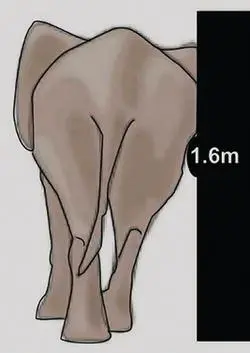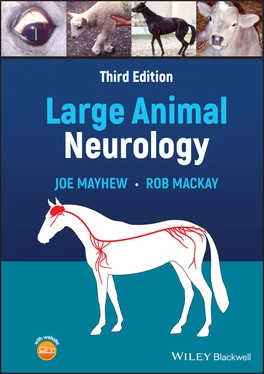Two novel neuropeptides (orexins), hypocretin 1 and 2, were found to be specifically expressed in certain hypothalamic neurons, and defective hypocretin signaling was related to both familial and sporadic narcolepsy. 3,21,22,24,25A mutation in the hypocretin receptor‐2 gene was present in dogs with familial narcolepsy although they had normal levels of hypocretins in their CSF and hypothalamus. Neurotransmission through hypocretin‐1 was likely to be intact indicating that defective hypocretin‐2 function is more important in producing narcolepsy in that model. In contrast, dogs with sporadic narcolepsy had no expressed hypocretins in the CSF or brain tissue. Hypocretin deficiency, as shown by low or absent concentrations in CSF, has been found in 90% of patients with sporadic narcolepsy with cataplexy, and less commonly in familial narcolepsy 26and in sleep deprivation, suggesting that disorders with marked cataplexy are more dependent on dysfunctional hypocretin pathways.
In the sporadic and some familial forms of the disease, various pieces of evidence indicate that there may be an autoimmune attack on hypocretin‐producing neurons and decreased hypocretin‐expressing neurons in the hypothalamus have been reported. 27–30Attempts to identify a neural autoantibody in canine and human narcolepsy have been unsuccessful; however, evidence for the presence of a functional, IgG autoantibody in serum of narcoleptic humans and not in controls which upregulates cholinergic activity, a characteristic of narcolepsy, has been presented. 31Further evidence that the immune system plays a role in canine genetically dependent narcolepsy has been published. One study found that immunosuppressive and anti‐inflammatory drugs delayed the onset and severity of narcolepsy and cataplexy in treated dogs compared to controls. Also, there has been an upsurge in acquired influenza vaccine‐induced narcolepsy type 1 (Pdmx‐NT1) and a loss of hypocretin‐producing neurons in this form of narcolepsy as well as in spontaneous narcolepsy type 1 (narcolepsy with cataplexy; sNT1). Results of attempts at treating narcolepsy in dogs with prednisolone and systemic and intrathecal hypocretin‐1 have been poor, perhaps because of depleted hypothalamic neurons. 34However, using alternating periods of desipramine and yohimbine (an α‐2 antagonist to activate adrenergic transmission) therapy for the cataplexy showed promise.
Many normal newborn foals can be induced into a sleep‐like state by firm, whole‐body restraint or cuddling to sometimes even lie still on the ground when released. 35This phenomenon wanes rapidly over a few days and it has been postulated that this is persistence of a protective mechanism that stops vigorous reflex movement occurring in utero, especially during birth.

Astute observational studies of sleep–wake cycling in domestic animals can result in modified environments to facilitate relaxed leaning behavior, as depicted here for an elephant using a leaning fence with horizontal protuberance for support. Source: Modified from Schiffmann et al . 36
Some syndromes of adult‐onset sleep attacks in large animals—especially horses—clinically resemble true narcolepsy with cataplexy; however, confirming limb atonia, limb areflexia, as well as onset of REM sleep at the onset of an episode does not appear to have been documented. Thus, it is likely that many of these cases of adult‐onset sleep attacks are examples of sporadic idiopathic hypersomnia, probably with influences of sleep deprivation as discussed above. 7Many factors of animal domestication, including disrupted social hierarchy, confinement, and occupational maladies, appear to be involved with lack of restful sleep, and astute observational programs can result in very useful management alterations to assist in restoring acceptable sleep–wake cycles. 36A detailed understanding of sleep patterns, including the associated encephalographic patterns, and determining the roles, if any, of hypocretin pathways and their immune attack in the various sleep disorders may help better characterize the syndromes and perhaps allow the use of specific therapy rather than palliative treatment of some of these disorders. 37–39
1 1 Siegel JM. Clues to the functions of mammalian sleep. Nature 2005; 437(7063): 1264–1271.
2 2 Williams DC, Holliday TA, Aleman MR, et al. Sleep in the horse: an electroencephalographic study. Am Coll Vet Int Med Forum 2002; ACVIM.
3 3 Kryger MH, Roth DT and Dement WC. Principles and Practice of Sleep Medicine. 4th ed. Saunders, Elsevier, Philadelphia, PA. 2005; 1552.
4 4 Dallaire A and Ruckebusch Y. Sleep patterns in the pony with observations on partial perceptual deprivation. Physiol behav 1974; 12(5): 789–796.
5 5 Ruckebusch Y. The relevance of drowsiness in the circadian cycle of farm animals. Anim behav 1972; 20(4): 637–643.
6 6 Ruckebusch Y, Barbey P and Guillemot P. Stages of sleep in the horse (Equus caballus). Comptes rendus des seances de la Societe de biologie et de ses filiales. 1970; 164(3): 658–665.
7 7 Bertone JJ. Sleep deprivation not narcolepsy in horses. Proc 24th Annual Forum Am Coll Vet Int Med, Louisville KY. 2006; 24: 167–169.
8 8 Pizza F, Antelmi E, Vandi S, et al. The distinguishing motor features of cataplexy: a study from video‐recorded attacks. Sleep 2018; 41(5): zsy026–zsy.
9 9 Pillen S, Pizza F, Dhondt K, Scammell TE and Overeem S. Cataplexy and its mimics: clinical recognition and management. Curr Treat Options Neurol 2017; 19(6).
10 10 Lyle CH and Keen JA. Episodic collapse in the horse. Equine Vet Educ 2010; 22(11): 576–586.
11 11 Hughes KJ. Diagnostic challenge: lethargy and weakness in an Arabian foal with cardiac murmurs. Ventricular septal defect (VSD). Aust Vet J 2006; 84(6): 209–212.
12 12 Lyle CH, Turley G, Blissitt KJ, et al. Retrospective evaluation of episodic collapse in the horse in a referred population: 25 cases (1995–2009). J Vet Intern Med 2010; 24(6): 1498–1502.
13 13 Reading PJ. Update on narcolepsy. J Neurol 2019; 266(7): 1809–1815.
14 14 Young TJ and Silber MH. Hypersomnias of central origin. Chest 2006; 130(3): 913–920.
15 15 de Lecea L and Sutcliffe JG. The hypocretins and sleep. FEBS J 2005; 272(22): 5675–5688.
16 16 Mignot E and Nishino S. Emerging therapies in narcolepsy‐cataplexy. Sleep 2005; 28(6): 754–763.
17 17 Scammell TE. The neurobiology, diagnosis, and treatment of narcolepsy. Ann neurol 2003; 53(2): 154–166.
18 18 Dauvilliers Y and Buguet A. Hypersomnia. Dialogues clin neurosci 2005; 7(4): 347–356.
19 19 Dauvilliers Y, Challamel MJ and Touchon J. (Sleep disorders in children and adults). La Revue du praticien 2003; 53(17): 1937–1946.
20 20 Tafti M, Maret S and Dauvilliers Y. Genes for normal sleep and sleep disorders. Ann med 2005; 37(8): 580–589.
21 21 Black JE, Brooks SN and Nishino S. Narcolepsy and syndromes of primary excessive daytime somnolence. Semin Neurol 2004; 271–282.
22 22 Kotagal S and Pianosi P. Sleep disorders in children and adolescents. Br Med J 2006; 332(7545): 828–832.
23 23 ICSD‐3 AAoSM. International Classification of Sleep Disorders, 3rd ed. Buysse DJ, Ed. American Academy of Sleep Medicine, Darien, IL. 2014.
24 24 Peyron C and Charnay Y. (Hypocretins/orexins and narcolepsy: from molecules to disease). Revue neurologique 2003; 159(11 Suppl): 6S35–6S41.
25 25 Black JE, Brooks SN and Nishino S. Conditions of primary excessive daytime sleepiness. Neurol Clin 2005; 23(4): 1025–1044.
26 26 Baumann CR and Bassetti CL. Hypocretins (orexins) and sleep–wake disorders. Lancet Neurol 2005; 4(10): 673–682.
Читать дальше













